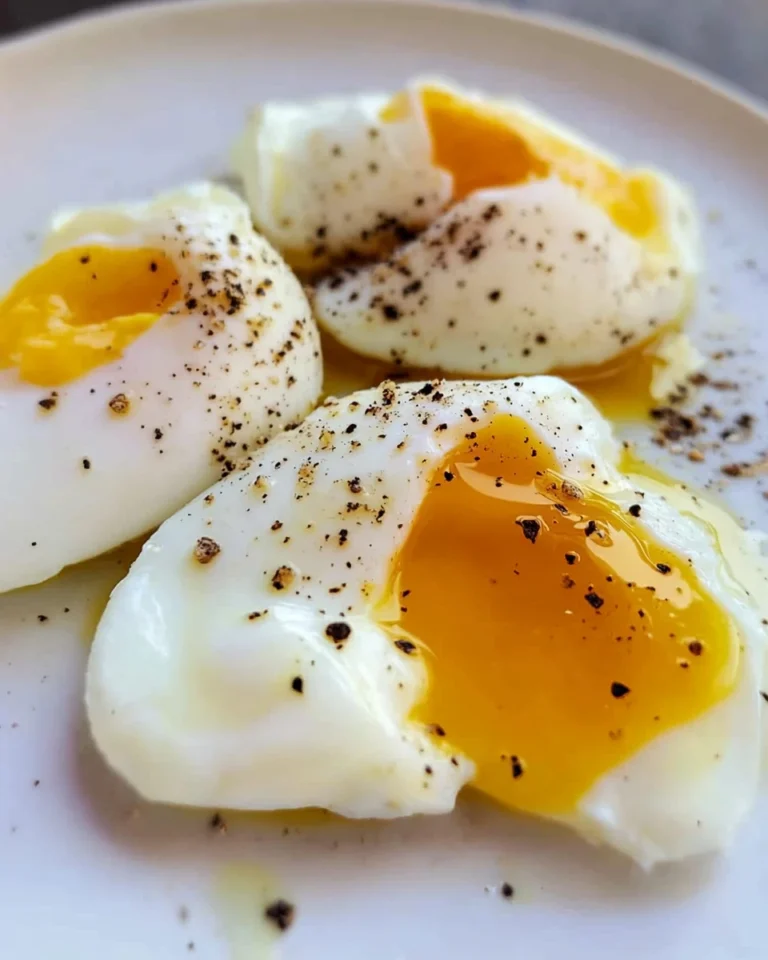Poached eggs are one of those brilliant breakfast favorites that’s both simple and sophisticated. Imagine the experience of slicing through a perfectly cooked egg, and watching that golden yolk spill out, adding richness to anything it touches. Whether you’re elevating your morning toast, dressing up a salad, or creating a hearty grain bowl, poached eggs elevate all these dishes, making them feel complete. It’s funny how something so basic can bring so much joy and flavor to the table. Plus, making poached eggs can impress anyone, from your sleepy partner to brunch guests who think you’ve got a secret chef’s technique up your sleeve! So let’s roll up our sleeves and dive into the wonderful world of poached eggs together.
Jump to:
- Why You’ll Love This Poached Eggs
- What is a Poached Eggs
- Ingredients for Perfect Poached Eggs
- Step-by-Step Guide to Poach an Egg
- Prepare the Pot for Cooking
- Strain the Egg
- Create a Vortex in the Water
- Pour the Egg into the Vortex
- Remove and Serve the Poached Egg
- Serving Suggestions
- Tips for Success
- Variations
- FAQs
- More Easy Appetizers & snacks Recipes:
- 📖 Recipe Card
Why You’ll Love This Poached Eggs
Poached eggs are a breakfast classic that combines simplicity, elegance, and exquisite flavor. With their tender whites and decadent runny yolks, these eggs create a delightful experience that elevates any meal. Whether you’re enjoying them on toast, incorporating them into a salad, or serving them atop a hearty grain bowl, you’ll be amazed by how poached eggs can enhance the dish and your overall dining experience.
What is a Poached Eggs
Poached eggs are eggs that have been cooked gently in simmering water without their shells. This cooking method results in delicate whites while maintaining a runny yolk, creating a creamy texture that’s perfect for a variety of dishes. The beauty of poached eggs lies in their versatility, making them suitable for breakfast, lunch, or dinner.
Ingredients for Perfect Poached Eggs
- 1 large egg
- 1 tablespoon vinegar (optional)
- Water (enough to fill a pot)
Step-by-Step Guide to Poach an Egg
Prepare the Pot for Cooking
Begin by boiling a large pot of water over high heat until it reaches a rolling boil. Once boiling, reduce the heat to low, allowing the water to settle to a gentle simmer. This helps create the ideal environment for poaching, ensuring that your egg cooks evenly without falling apart.
Strain the Egg
Crack your egg into a fine mesh sieve positioned over a small bowl. This technique helps to remove excess egg whites for a neater poach. Once strained, carefully transfer the egg into a small ramekin or bowl. This will make it easier to slide the egg into the water without creating a mess.
Create a Vortex in the Water
If you choose to use vinegar, add it to the simmering water. Stir the water vigorously to create a vortex. This motion helps to keep the egg together as it cooks. If you’re poaching only one egg, this is especially useful. Keeping everything contained means you’ll have a beautifully formed poached egg at the end.
Pour the Egg into the Vortex
Gently slide the egg from the ramekin into the center of the vortex. Take care to avoid splashing water. Now, set a timer for 3 minutes; this ensures the egg attains the perfect runny yolk. Waiting patiently as the egg cooks can be the hardest part, but it will be worth it!
Remove and Serve the Poached Egg
Using a slotted spoon, carefully lift the poached egg from the water. Dab it gently with a paper towel to absorb any excess water. Serve immediately for the best texture and flavor. If you can, enjoy it fresh, right from the pot, for a delightful experience.
Serving Suggestions
Poached eggs can be enjoyed in a myriad of ways. Serve them atop:
- Avocado Toast
- A fresh salad with arugula and cherry tomatoes
- A classic Eggs Benedict
- A warm grain bowl with quinoa or farro
- Sautéed spinach or greens for an extra nutritious punch
Mixing and matching will only enhance your options and creativity in the kitchen. The beauty of poached eggs is how well they complement various flavors.
Tips for Success
- Use fresh eggs for the best results; they hold their shape better when poached.
- Maintain a gentle simmer, as vigorous boiling can break apart the egg.
- If you’re new to poaching, start by trying one egg at a time for easier management. This will make the process less intimidating.
Variations
Feel free to experiment with different flavor profiles by adding:
- Herbs like dill or chives to the water for aromatics
- A splash of lemon juice instead of vinegar for a citrusy touch
- Seasoned salt or pepper directly onto the finished egg to add extra flavor
Trying out these variations can turn a simple poached egg into a unique masterpiece that suits your taste preferences perfectly.
FAQs
1. Can I use eggs that are not fresh for poaching?
Using fresh eggs is ideal for poaching as they hold their shape better, but slightly older eggs can still work if you’re careful. Just bear in mind they might spread out more while cooking.
2. What if my eggs don’t hold their shape?
If your eggs spread out too much, try using a slotted spoon to gently guide them back together in the water while they cook. A little help can make a big difference.
3. Can I poach multiple eggs at once?
Yes, you can poach several eggs at once, but it’s best to use a large pot to ensure they have enough room to cook without sticking together. Doing this requires a bit of attention, so manage your space wisely.
4. What dishes pair well with poached eggs?
Poached eggs are fantastic with toast, salads, grains, or even served solo for a light breakfast or snack. They really enhance whatever they are paired with!
5. Is it necessary to add vinegar when poaching?
While vinegar helps to coagulate the egg whites and can lead to a more compact egg, it is not essential and can be omitted if preferred. Everyone has their own preference, so feel free to experiment.
Poached eggs are not just a meal; they’re a culinary adventure waiting to happen. With this simple guide and a little practice, you’ll master the art of poaching eggs and delight your taste buds. Embrace the elegance of poached eggs and make them a staple in your cooking repertoire! Enjoy experimenting with different serving suggestions and variations; the possibilities are endless, making this dish a favorite for breakfast aficionados.
More Easy Appetizers & snacks Recipes:
Did You Enjoy Making This Recipe? Please rate this recipe with ⭐⭐⭐⭐⭐ or leave a comment.
📖 Recipe Card
Print
Poached Eggs
Poached eggs are a breakfast favorite, blending simplicity with elegance. Their runny yolk and tender whites elevate any meal, making it special and enjoyable.
- Total Time: 8 minutes
- Yield: 1 poached egg 1x
Ingredients
- 1 large egg
- 1 tablespoon vinegar (optional)
- Water (enough to fill a pot)
Instructions
- Boil a large pot of water, then reduce to a gentle simmer.
- Strain the egg in a fine mesh sieve to remove excess whites.
- Add vinegar to water, stir to create a vortex.
- Gently slide the egg into the vortex and set a timer for 3 minutes.
- Lift the poached egg with a slotted spoon and serve.
Notes
Use fresh eggs for better shape and texture while poaching.
Maintain a gentle simmer to avoid breaking the egg.
Start with one egg at a time for easier poaching.
- Prep Time: 5 minutes
- Cook Time: 3 minutes
- Category: Breakfast
- Method: Poaching
- Cuisine: Global
Nutrition
- Calories: 70
- Sugar: 0
- Sodium: 70
- Fat: 5
- Saturated Fat: 1.5
- Unsaturated Fat: 3
- Trans Fat: 0
- Carbohydrates: 1
- Fiber: 0
- Protein: 6
- Cholesterol: 186







